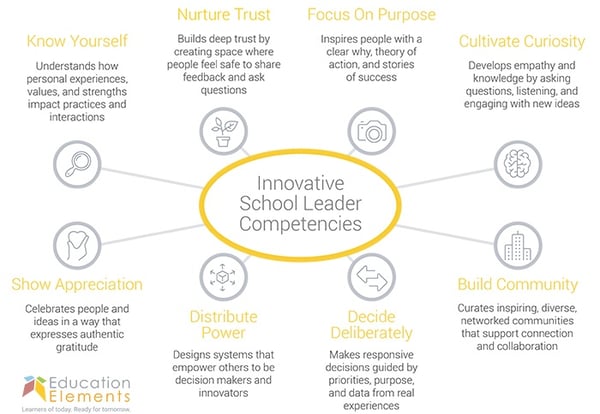Ideas come to me at very random times: in a dream, on a walk, or during my commute. I think “Wow, this is it...this is the idea that will land me a TED Talk!” Following these inspirations, I usually text my colleague and warn her: “This is going to be big! We should carve out a whole hour to talk about it.” Within the first five minutes of our conversation, she has completely blown up my idea in all of the best ways. She preserves the spirit of the inspiration while somehow making it better. We then conference in another colleague who amps up our idea by helping us consider new perspectives. He encourages us to share it with our team to accelerate our learning. What we end up moving forward with is always beyond what I alone could have imagined!
I was excited to learn that this process is mirrored more formally in other settings. If you were to enter the writers' room of the Daily Show, a popular comedic news program, you would see creative ideas bursting across the room, rapid-fire feedback, and the absence of a single dominating voice. Why? Because the Daily Show writers engage in a creative process called "Burstiness" rather than brainstorming. In brainstorming, there is a slow, methodical approach to sharing new ideas and reserving feedback until all voices have been heard. Burstiness, however, requires a quick exchange of ideas, feedback, more ideas, and more feedback. Rather than spend a dedicated block of time brainstorming and then planning, a team described as "bursty" would be captivated by a constant cycle of iteration so the best ideas are achieved quickly and by a mix of voices. Creating the conditions required for burstiness to occur includes building trust, familiarity, diversity, and comfort with peers.
The NEW School Rules Self Strengths Audit Tool
We improve when we know our strengths and weaknesses
It’s amazing what a group of people can accomplish when they come together, whether it’s to refine an idea for 20 or for an audience of millions to innovate. In the previous installment of the Innovative School Leaders, we focused on exploring how leadership impacts the “me.” In this post, we will move from the “me to we” to explore how the culture of innovation so evident in a daily show writers’ room or a phone call with a colleague can be distilled into outward facing competencies: Cultivate Curiosity, Build Community, and Show Appreciation.
Click to download a high-res PDF.
Outward Facing Competencies for Innovative School Leaders
CULTIVATE CURIOSITY: Develop empathy and knowledge by asking questions, listening and engaging with new ideas.
WHY? At Education Elements one of our values is “Constantly Learning” because we know that absent of this, our dynamic learning communities would not exist. In these communities, we are encouraged to step outside of our comfort zones by researching a particular interest or theory, testing it out and sharing best practices with colleagues. As a result, everyone gets smarter and our clients benefit from cutting-edge ideas and solutions. Some of our best work has been the results of individuals who explored a particular interest and pushed our team to expand our perspectives. As a result, we have developed: 5 Ingredients to Create a Culture of Innovation, the Core Four Continuum, and the CBE Toolkit.
HOW? Similarly, in districts where we see significant growth, we also see communities of learning emerge. According to Francesca Gino, creating a culture of curiosity has immense benefits such as fewer decision-making errors, more innovation and positive change, reduced conflict, and more open communication. If you want to Cultivate Curiosity with your team, check out the Ladder of Competence. You can also start by reflecting on some of the following questions:
- When was the last time you learned something new?
- What is something that you learned at some point in your life that you no longer have to think about because it has become natural to you?
- How patient are you when others are learning new skills?
- How do you prioritize time to learn for yourself and others?
BUILD COMMUNITY: Curate inspiring, diverse, networked communities that support connection and collaboration.
WHY? In 2012 The New Teacher Project (TNTP) published a report aptly named “The Irreplaceables” exploring the crisis in school districts to retain top talent. Detailed in the report are the many reasons exceptional teachers are needed in the school system: replacing their talent and skills is challenging. In exploring the retention crisis, one of the causes noted is that ”poor cultures and working conditions drive away great teachers.” If we know that negative cultures drive away our best teachers, what tools can we employ to ensure a healthy and quality school culture that compels them to stay?
HOW? Research out of Google underscores the importance of intentional culture building. Matt Sakaguchi, a team leader at Google, discusses what it takes to create a strong community in a team of all-stars. Additionally, the Carnegie Foundation has researched the process of creating networks in education. If you want to Build Community we recommend:
- Create shared goals because they are less intimidating than being evaluated on your own.
- Encourage collaboration by removing barriers, creating structures, and celebrating team efforts.
- Build people’s sense of belonging by connecting them with peers, helping them find strong advocates, and finding opportunities to contribute ideas that in turn might be respected and valued.
SHOW APPRECIATION: Celebrate people and ideas in a way that expresses authentic gratitude.
WHY? Gratitude and appreciation are terms we often hear in the context of wellness and self-improvement. While small acts of thanks are impactful on a “feel good” level, there are some practical reasons why appreciation is essential to a strong work culture. A recent Forbes study shows that 35% of employees cite a lack of recognition as a hindrance to their productivity. According to Performance: Accelerated, 79% of individuals who quit their jobs name lack of appreciation as their primary reason for leaving.
HOW? The previously mentioned TNTP report offers effective and low-cost retention strategies that can lead to strong teachers staying up to 6 years compared to teachers who do not receive these interventions. Many of which highlight that folks are motivated by appreciation rather than recognition. If you couple these strategies with managing healthy teams you can lead a community of motivated and inspired teachers!
|
Provide an Individual with: |
Provide a team with: |
|
|
Want to be a strong and innovative leader? Take some time and explore the resources shared within this post and reflect on the following questions:
- What was the last thing you learned? What makes you and others curious?
- What problems could you solve with the help of a greater community?
- How do individuals in your community show appreciation? How do you show others you appreciate them?
We’d love to hear from you, so Tweet us @EdElements #LeadToInnovate
Read Part 1: How to Become an Innovative School Leader, and Part 3: Leading with Intention.






